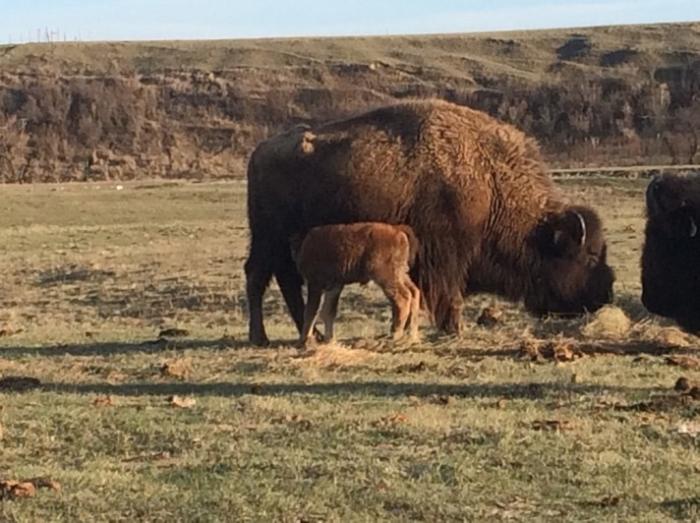Beef Bison Ranch Expands with Technical Aid in Billings County
Indian Springs Bison owner Roy Krivoruchka and his family have raised bison near Belfield the past 25 years, and when they wanted to expand their feedlot, they turned to the Natural Resources Conservation Service (NRCS) in Billings County for assistance.
Luann Dart writes from Elgin, N.D
Staff from the NRCS Dickinson field office were able to provide both expertise and cost-share assistance to the ranch to construct a wastewater management system that is certified by the N.D. Department of Health.
Krivoruchka raises 150 commercial Angus and Angus/Hereford cross beef cattle. Twenty-five years ago, he expanded into bison also.
“I was looking for a lighter load,” he said. With a full-time job with Billings County at the time, he found bison required less maintenance than beef cattle, due to calving ease and fewer health issues.
“We tried the buffalo side and we enjoyed it and, so we just expanded into it. It’s less demanding. We don’t have the calving issues and we don’t have a lot of issues in the feedlot,” he said.

Today, he has 50 buffalo cows, and he purchases 400-pound buffalo calves in the fall for a 500-head feedlot.
Krivoruchka has since left his job with Billings County, but also started a reclamation company, so he still appreciates the low maintenance of the bison.
“They’re more maintenance-free. We don’t have an overeating issue with them. We have very little veterinary expenses and usually no calving problems. They’re hardy, they’re tough,” he said.
Eighteen years ago, NRCS assisted with building an ag waste management system on the ranch.
“We were concerned with the wastewater going into the Green River and they could see the cheapest, simplest route for a producer to use,” Krivoruchka said.
The feedlot is located on a hillside along a shelterbelt, so a diversion dike was constructed along the shelterbelt that moves the snowmelt water away from the feedlot and into a nearby creek.
Wastewater from the feedlot follows a gradual downhill slope into a natural drainage where an embankment was installed to form a holding area, preventing wastewater from entering the Green River.
NRCS has also assisted with renovation of existing shelterbelts and adding additional shelterbelts that surround the farmyard and feedlot.
“Conservation assistance provided by SCS/NRCS to the Krivoruchkas over the years has been an ongoing process that started with Roy’s parents. It has moved in a different direction over the years, changing the once farming and ranching operation into the present bison and beef operation that meets Roy’s conservation and management goals. The Natural Resources Conservation Service has been able to make this possible for Roy through our technical and financial assistance,” said Russell Jordre, District Conservationist with NRCS in Dickinson.
NRCS also assisted Krivoruchka with developing a rotational grazing system for both his beef cattle and bison.
To facilitate his grazing system, NRCS has assisted Krivoruchka with establishing cross fencing, and drilling water wells and installing 1.5 miles of pipeline with stock tanks so the animals would have fresh water in each pasture. Krivoruchka also utilized the NRCS Environmental Quality Incentives Program (EQIP) to install solar panels at a water well so water could be available in a more remote area without electricity.
In his feedlot, Krivoruchka feeds the heifers to 1,000 pounds and the bulls to 1,200 pounds or more, then markets the heads, hides and meat from the bison.
About 60 animals are slaughtered from the ranch, while the rest are shipped to the Western Buffalo Company in Rapid City, S.D., or to Rocky Mountain Natural Meats in Brush, CO.
With a foundation of consumer demand, bison burgers and steaks are now common menu items at mid-level restaurants, and buffalo ranchers are experiencing a stable market.
“It’s been very rewarding for us the whole time we’ve been in it,” Krivoruchka said.

